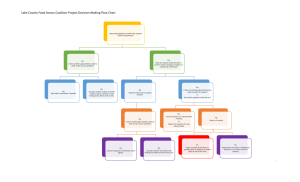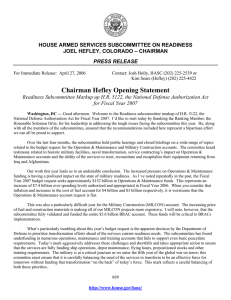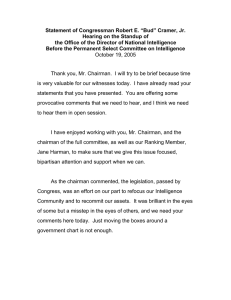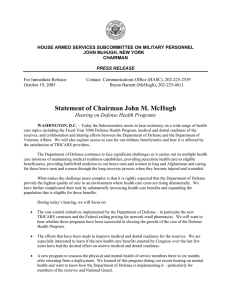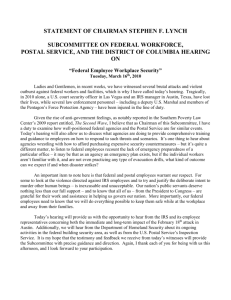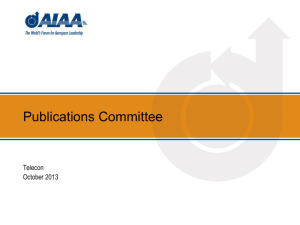For Immediate Release: Contact: Josh Holly (HASC), 202-225-2539
advertisement
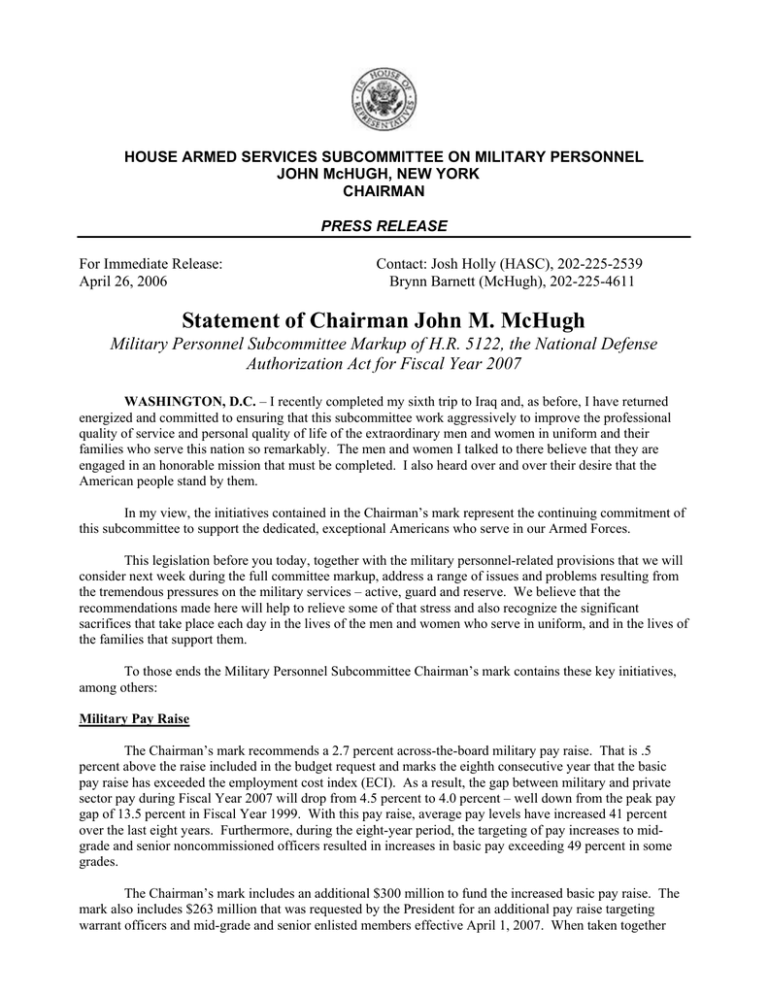
HOUSE ARMED SERVICES SUBCOMMITTEE ON MILITARY PERSONNEL JOHN McHUGH, NEW YORK CHAIRMAN PRESS RELEASE For Immediate Release: April 26, 2006 Contact: Josh Holly (HASC), 202-225-2539 Brynn Barnett (McHugh), 202-225-4611 Statement of Chairman John M. McHugh Military Personnel Subcommittee Markup of H.R. 5122, the National Defense Authorization Act for Fiscal Year 2007 WASHINGTON, D.C. – I recently completed my sixth trip to Iraq and, as before, I have returned energized and committed to ensuring that this subcommittee work aggressively to improve the professional quality of service and personal quality of life of the extraordinary men and women in uniform and their families who serve this nation so remarkably. The men and women I talked to there believe that they are engaged in an honorable mission that must be completed. I also heard over and over their desire that the American people stand by them. In my view, the initiatives contained in the Chairman’s mark represent the continuing commitment of this subcommittee to support the dedicated, exceptional Americans who serve in our Armed Forces. This legislation before you today, together with the military personnel-related provisions that we will consider next week during the full committee markup, address a range of issues and problems resulting from the tremendous pressures on the military services – active, guard and reserve. We believe that the recommendations made here will help to relieve some of that stress and also recognize the significant sacrifices that take place each day in the lives of the men and women who serve in uniform, and in the lives of the families that support them. To those ends the Military Personnel Subcommittee Chairman’s mark contains these key initiatives, among others: Military Pay Raise The Chairman’s mark recommends a 2.7 percent across-the-board military pay raise. That is .5 percent above the raise included in the budget request and marks the eighth consecutive year that the basic pay raise has exceeded the employment cost index (ECI). As a result, the gap between military and private sector pay during Fiscal Year 2007 will drop from 4.5 percent to 4.0 percent – well down from the peak pay gap of 13.5 percent in Fiscal Year 1999. With this pay raise, average pay levels have increased 41 percent over the last eight years. Furthermore, during the eight-year period, the targeting of pay increases to midgrade and senior noncommissioned officers resulted in increases in basic pay exceeding 49 percent in some grades. The Chairman’s mark includes an additional $300 million to fund the increased basic pay raise. The mark also includes $263 million that was requested by the President for an additional pay raise targeting warrant officers and mid-grade and senior enlisted members effective April 1, 2007. When taken together with the across-the-board raise, these targeted raises will enhance retention efforts directed at experienced and highly skilled noncommissioned officers and warrant officers. Active and National Guard End Strengths The Chairman’s mark reflects the continuing belief that the manpower levels in the budget request for the active components of the Army and the Marine Corps are too low for the requirements placed on those services by the national security strategy. Beginning with the National Defense Authorization Act for Fiscal Year 2003, as passed by the House of Representatives, the committee has supported active end strength levels, especially for the Army, greater than those requested. Similarly, the committee’s recommendations for Fiscal Year 2007 increase the active Army end strength by 30,000, or six per cent, and the Marine Corps end strength by 5,000, or nearly 3 percent above the budget request. Furthermore, in recognition of the integral roles and missions performed by the reserve components, the Chairman’s mark supports the decision by the Army Secretary and Chief of Staff to request an Army National Guard end strength of 350,000. In addition, the mark would increase Army National Guard full-time support personnel by nearly 2,300. To support the additional manpower, the Chairman’s mark would increase Army National Guard funding by $471 million. Health Care The military and civilian leaders of the Department of Defense (DOD) have energetically advocated measures to manage the growing cost of health care and sustain the TRICARE benefit. Reflecting an examination of those proposals, the Chairman’s mark would prohibit (until December 31, 2007) the Department’s ability to increase TRICARE Prime, Standard and TRICARE Reserve Select cost shares. That delay will allow the subcommittee to assess recommendations from an independent task force, as well as the Comptroller General and the Congressional Budget Committee, for a comprehensive policy and fiscal basis for sustaining the future military health care benefit. The mark would also add $735 million to the Defense Health Program to restore funding cut from DHP by the budget request in anticipation of increased beneficiary cost shares. Notwithstanding the deferral of some TRICARE cost share increases, there are additional measures that the committee believes should be taken now to improve the pharmacy benefit and to enable the Department to better manage the overall costs of health care. Because some of the initiatives, including a change in pharmacy cost shares that would make most mail order prescriptions free to the beneficiary, have mandatory spending costs or are still being coordinated with other committees of jurisdiction, they will be included in Chairman Hunter’s full committee mark. Other health care initiatives recommended in the Military Personnel Subcommittee’s mark include: • • • TRICARE coverage for forensic examinations following sexual assaults and domestic violence; TRICARE coverage for anesthesia and hospital costs for dental care provided to young children and mentally or physically challenged beneficiaries; and, A demonstration project to evaluate the benefits of including over-the-counter drugs as an additional option in the pharmacy benefits program. Recruiting and Retention Key recruiting, retention and pay initiatives in the mark include: • • • An additional $100 million for Army recruiting and retention bonuses; $100 million for the Army Reserve to fund Army-wide basic officer courses; and $59 million for Air National Guard bonuses; An increase in the maximum annual rate of special pay for Selected Reserve health care professionals in critically short wartime specialties from $10,000 to $25,000; An increase in the maximum amount of the nuclear career accession bonus from $20,000 to $30,000; • • • An increase in the maximum amount of the incentive bonus for transfer between armed forces from $2,500 to $10,000; A two-year pilot program to offer additional financial recruiting incentives under the Armed Forces Health Professions Scholarship and Financial Assistance Program for up to five critical medical specialties; and A test to determine whether commercially available test preparation guides and education programs would assist recruit candidates in achieving improved scores on military recruit qualification tests. Casualty Assistance Programs Oversight efforts by the subcommittee have identified the need to improve the programs that directly affect not only those who have been wounded or injured, but provide for the surviving family members of those who have died or have been seriously injured in service. Therefore, the mark: • • • • Requires that the remains of military personnel who die during combat operations or who die of noncombat related injuries in the theater of combat, be moved by dedicated military or military leased aircraft, from Dover Air Force Base, Delaware, to the military airfield nearest to the service members place of interment or to a location designated by the next of kin. It also requires that proper military honors be rendered by military personnel at the destination airfield. Reforms the military services’ physical evaluation board (PEB) process (the process that awards disability ratings) to address concerns of military members, particularly reserve component members, about the consistency and timeliness of PEB decisions, the ability of members to gain information about PEB procedures, and the rationale supporting board decisions. Authorizes the Secretary of Defense to provide computer/electronic assistive technology, devices, and technology services to military personnel who have sustained a severe or debilitating illness or injury while serving in support of a contingency operation. Such devices and services could be provided for an indefinite period, without regard to whether the person being assisted continues to be a member of the armed forces. Directs the development of a comprehensive and systematic approach for the identification, treatment, disposition and documentation of traumatic brain injuries, given the increased incidence of traumatic brain injury in our returning combat veterans. POW-MIA Programs I was very disappointed to learn this year of a significant budget shortfall in the Joint POW/MIA Accounting Command (JPAC) that led to an inexcusable reduction in operations in Southeast Asia and other locations. While some of the JPAC funding shortfall has been restored, JPAC still remains underfunded for fiscal year 2006. In the past, this subcommittee has paid particular attention to funding and manning issues in the Defense Prisoner of War/Missing Personnel Office, but not in the other DOD organizations that are critically important to the accounting mission. In addition to JPAC and DPMO, the other organizations are the Armed Forces DNA Identification Laboratory, and the Air Force’s Life Sciences Equipment Laboratory. I understand that funding and manning shortfalls also exist in the latter two organizations, and am committed to seeing that all four of these organizations are fully funded and manned. The first step in effective Congressional oversight of the DOD and service commitment to the accounting effort is getting visibility over the budgets these organizations. Therefore, the mark also requires that future budget justification materials explain the full range of funding required and requested by all four major Department of Defense organizations directly involved in the full accounting of U.S. military personnel missing in action and prisoners of war. As we put together the recommendations of the mark and throughout the year I have worked closely with the subcommittee’s Ranking Democrat, Dr. Vic Snyder, and have been assisted by the active participation of the subcommittee members. That has ensured that the recommendations included here represent a bi-partisan effort. I want to thank all the subcommittee members for their contributions and involvement. ### http://armedservices.house.gov/
